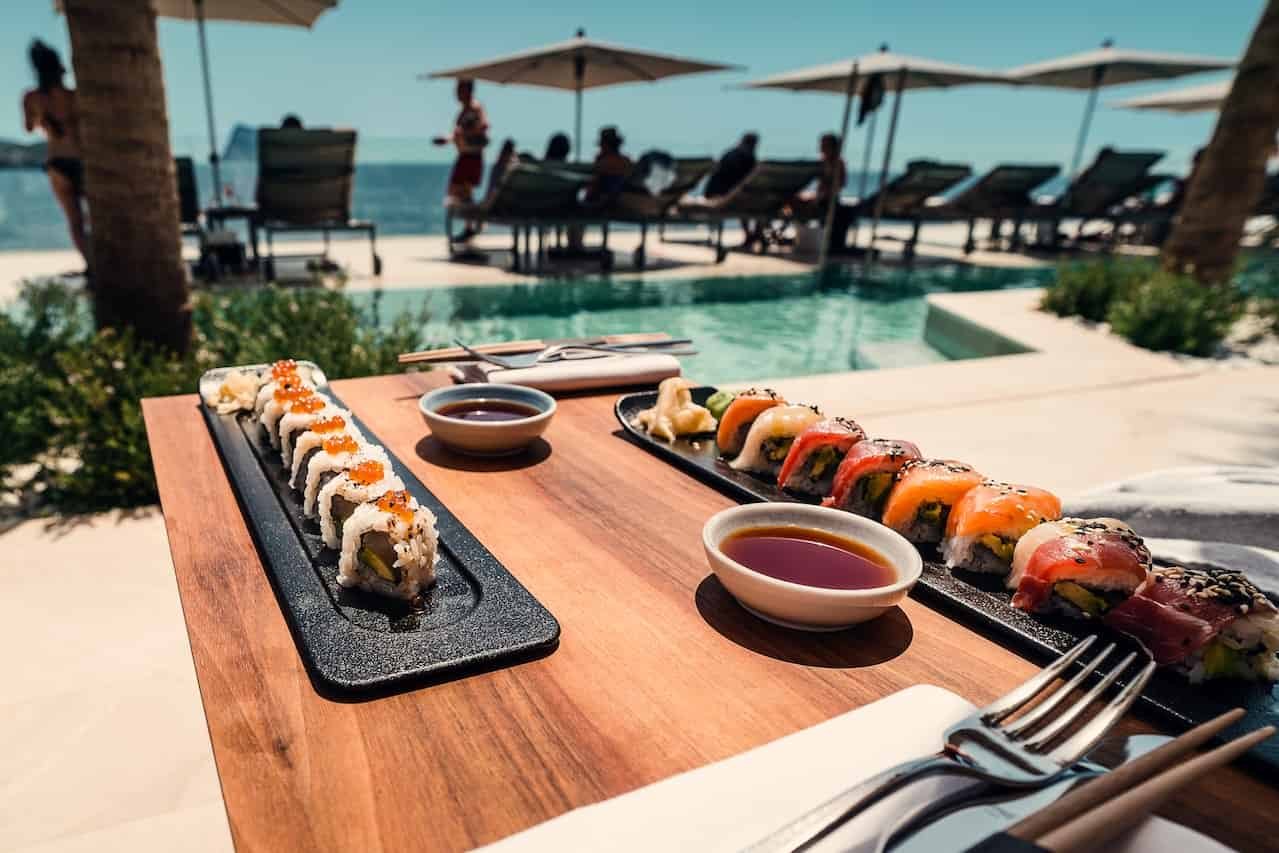Introduction
Nestled in the azure waters of the Mediterranean Sea, the enchanting island of Ibiza is known for its vibrant nightlife, stunning beaches, and magnetic charm. But beyond the bustling clubs and sandy shores, Ibiza boasts a lesser-known treasure that delights the senses and captivates the heart: its gastronomic delights. In this blog post, we embark on a mouthwatering journey through the diverse and flavorful cuisine of Ibiza, exploring the island’s rich culinary history, traditional dishes, and the fusion of international influences that have shaped its contemporary food scene. From traditional seafood delicacies to modern fine dining experiences, Ibiza’s captivating cuisine offers a delectable adventure for every food lover.
1. The Culinary Heritage of Ibiza
Ibiza’s culinary heritage is a captivating fusion of history and tradition, reflecting the island’s centuries-old connection to various civilizations. The Phoenicians introduced vineyards and the cultivation of figs, pomegranates, and almonds, while the Romans brought their culinary flair, introducing wheat, grapes, and olives. Later, the Moors added their influence with spices and irrigation techniques that transformed the island’s agricultural practices. Over time, the blending of these diverse influences gave rise to the distinctive Ibicenco cuisine we know today.
The traditional dishes of Ibiza speak volumes about the island’s past. “Arroz de Matanzas,” a rustic rice dish infused with a mix of meats and vegetables, pays homage to the age-old practice of communal pig slaughters. “Sofrit Pages,” mentioned earlier, is another noteworthy example, believed to have originated from the island’s farming communities, making the most of locally available ingredients. These traditional recipes have been lovingly preserved by generations of families, passed down through oral tradition and cherished handwritten cookbooks.
2. The Bountiful Sea: Seafood Delicacies
Ibiza’s relationship with the sea is inseparable from its culinary identity. The island’s fishermen still employ age-old techniques to bring in fresh catches each day, keeping the tradition alive. The renowned Ibicenco “bullit de peix” and “arroç a la marinera” are two dishes that embody the essence of the island’s maritime heritage. “Bullit de peix” is a flavorful fish stew made with rockfish, grouper, and monkfish, simmered to perfection and served with a side of fragrant saffron rice. “Arroç a la marinera,” on the other hand, is a seafood paella with prawns, squid, mussels, and the finest saffron-seasoned rice.
Ibiza’s fishing villages, such as Sant Antoni de Portmany and Santa Eulària des Riu, showcase the deep-rooted connection between the islanders and the sea. Restaurants in these areas offer a delightful array of seafood delicacies, often accompanied by stunning coastal views that add to the allure of the dining experience.
3. Ibiza’s Authentic Flavors: Olives, Olive Oil, and Salt
Olives have been an integral part of Ibiza’s agricultural landscape for centuries, with olive trees dotting the island’s terrain. The “arbequina” and “empeltre” varieties are commonly grown, their fruits plucked at their peak to produce some of the finest olive oils in the region. The olive harvest season, typically in late autumn, is a time of celebration on the island, with locals coming together to handpick the olives and press them into liquid gold.
Ibiza’s sea salt production is just as significant to the island’s culinary history. The evaporation ponds, locally known as “salinas,” have been used to harvest salt since ancient times. Today, “Flor de Sal d’Eivissa,” the island’s prized sea salt, is hand-harvested and enjoyed not only in traditional dishes but also in gourmet restaurants worldwide.
4. Tapas Culture: A Social Culinary Experience
The tradition of “pica pica,” or sharing tapas, has deep social roots in Ibiza’s culture. It is a way of life that brings together locals and visitors alike, fostering a sense of community and camaraderie. Picture a balmy evening, with friends gathered around a table, sharing laughter and stories while sampling an assortment of small plates.
The tapas scene in Ibiza is as diverse as its visitors, with an array of options to suit every palate. “Pan con tomate,” a simple yet delicious dish of bread rubbed with ripe tomatoes and drizzled with olive oil, is a staple that exemplifies the beauty of traditional Spanish tapas. Additionally, “pimientos de padrón,” green peppers sprinkled with sea salt, offer a delightful touch of surprise, as some are mild while others pack a spicy punch.
5. From Farm to Table: Organic Delights
The farm-to-table movement is thriving on Ibiza, as a growing number of restaurants and local markets emphasize the use of locally sourced, organic ingredients. The island’s fertile land yields an abundance of fresh fruits, vegetables, and herbs, which find their way to dining tables with minimal intervention, preserving their natural flavors and nutritional value.
Visitors looking to immerse themselves in the farm-to-table experience can explore the various agrotourism farms on the island. These enchanting rural retreats offer not only a glimpse into organic farming practices but also the opportunity to enjoy farm-fresh meals prepared with love and attention.
6. Fusion Cuisine: A Global Culinary Adventure
As a cosmopolitan destination attracting people from around the world, Ibiza’s culinary scene has evolved to cater to diverse tastes and preferences. Innovative chefs take inspiration from different culinary traditions, infusing them with local ingredients and techniques to create unforgettable gastronomic experiences.
Whether you’re dining in the bustling streets of Ibiza Town or along the picturesque coastline, fusion restaurants abound, offering a world of flavors on one island. The marriage of Japanese sushi with Ibiza’s freshest catch, or the fusion of Mediterranean and Asian cuisines, exemplify the culinary creativity that knows no boundaries on this enchanting island.
7. Desserts and Sweet Treats: A Sweet Farewell
No gastronomic journey is complete without indulging in the sweeter side of Ibiza’s cuisine. The island boasts a delightful array of desserts and pastries that cater to every sweet tooth. “Orelletes,” delicate anise-flavored pastries, and “Flaó,” a delectable cheesecake infused with local herbs, are just a few examples of the sweet treasures awaiting those with a craving for sugary delights. Be it in a quaint bakery or a charming café, the dessert scene in Ibiza is sure to leave a lasting impression.
FAQ
Q: What is the significance of “Bullit de Peix” in Ibiza’s culinary culture?
A: “Bullit de Peix” holds a special place in Ibiza’s culinary history as a traditional dish that symbolizes the close relationship between the island and the sea. The name “Bullit de Peix” translates to “fish boil,” referencing the method of cooking the fish at a gentle simmer, allowing the flavors to meld harmoniously. This dish has its roots in the fishing communities, where fishermen would prepare it on their boats using the day’s catch. Today, it is a must-try for visitors seeking an authentic taste of Ibiza’s maritime heritage.
Q: What are the best locations to experience Ibiza’s tapas culture?
A: Ibiza Town and Santa Eulària des Riu are fantastic places to immerse yourself in the island’s tapas scene. In Ibiza Town, head to the quaint alleys of Dalt Vila or the bustling Mercat Vell (Old Market) to find a variety of tapas bars and eateries. Santa Eulària des Riu’s seafront promenade, dotted with tapas bars, offers a delightful ambiance for sampling the local cuisine while enjoying beautiful views of the sea.
Q: Is it possible to visit the olive oil mills and salt pans on Ibiza?
A: Yes, several olive oil mills and salt pans are open to visitors, providing an opportunity to learn about these age-old traditions and witness the production process firsthand. You can explore the olive groves, observe the pressing of olives into oil, and even taste freshly made olive oil at some mills. The salt pans offer guided tours where you can learn about the salt harvesting techniques and the importance of sea salt in Ibiza’s culinary heritage.
Q: Are there any unique desserts that are exclusive to Ibiza?
A: Yes, one such exclusive dessert is “Greixonera,” a rich bread pudding featuring local ingredients like ensaimadas (spiral-shaped pastries) and flaó cheese. Another traditional delight is “Flaó,” a cheesecake infused with anise and mint, often enjoyed during festive occasions. “Orelletes,” mentioned earlier, are also a unique pastry to Ibiza, reminiscent of delicate and crisp anise-flavored ribbons. Sampling these desserts is a delightful way to round off your culinary adventure on the island.
Conclusion
As we bid farewell to Ibiza, it’s evident that the island’s gastronomic delights are a journey of the senses, a tale of tradition, innovation, and a celebration of life. Ibiza’s captivating cuisine not only tantalizes the taste buds but also reveals the island’s rich history, cultural diversity, and passion for culinary excellence. Whether you’re savoring freshly caught seafood by the sea or enjoying a farm-to-table meal in the heart of the island, each bite is a symphony of flavors that speaks to the soul of Ibiza. So, the next time you find yourself on this Mediterranean gem, venture beyond the dance floors and beaches, and immerse yourself in the captivating cuisine that has earned Ibiza a place in the hearts of food lovers worldwide. Bon appétit!





